Viburnum shrubs are a diverse group of woody plants. They are characterized by large, scented flowers, vibrant autumn foliage and colorful fruits. These shrubs can be found throughout the world, including temperate regions of Europe, Asia and North America.
Either growing as shrubs or small trees, Viburnums include evergreen, semi-evergreen and deciduous plants. In spring many viburnums bear bewitching white to pink flower clusters often followed by dark berries that persist into the winter.
Viburnums have attractive leaves and many deciduous varieties display dramatic red to purple fall foliage.
Viburnum shrubs go by many names, including the European cranberry bush, the American cranberry bush and the hobblebush.
There are many different types of viburnum shrubs. Some are ideal for use as foundation plants or hedges, while others are well-suited for use in naturalized areas or as specimen plants.
In this article, let’s look at the different types of viburnum shrubs around the world.
List of Viburnum Shrubs
- Mapleleaf viburnum
- Blackhaw viburnum
- Wayfaring tree
- Sandanqua viburnum
- Siebold viburnum
- Nannyberry
- Burkwood viburnum
- Judd viburnum
- Shasta Viburnum
- David viburnum
- Eskimo viburnum
- Prague viburnum
- Leatherleaf viburnum
- Cinnamon viburnum
- Henry’s viburnum
- Korean spice viburnum
- Laurustinus viburnum
- Snowball bush viburnum (Viburnum opulus)
- Arrowwood viburnum
- Tubeflower viburnum
- Awaki viburnum
Characteristics And How To Use Them
Mapleleaf viburnum
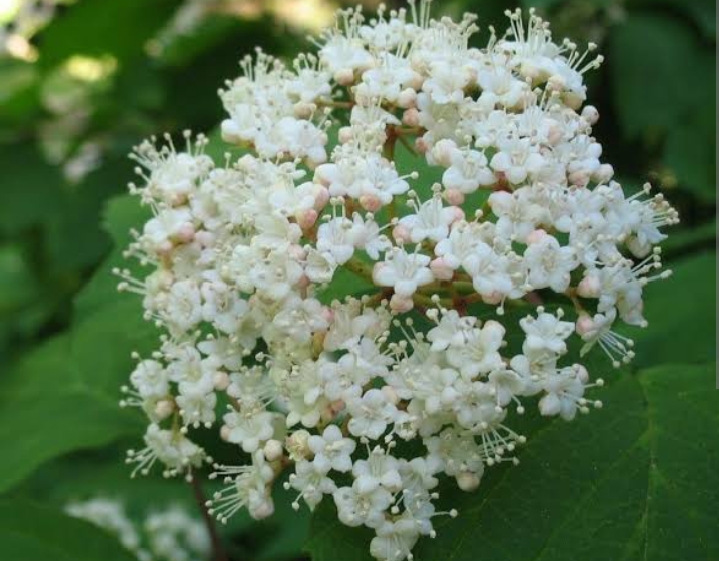
- Scientific Name: Viburnum acerifolium
- Nature: Deciduous shrub
- Height: 4-6 feet
- Flowers: White flower
- USDA zones: 4 through 8
The Mapleleaf viburnum is a deciduous shrub that grows to a height of approximately 4 or 6 feet. It features lobed foliage or maple-like leaves that are 3-5 inches long and wide, and are a deep green color. They turn a beautiful red-purple in the fall.
The flowers of Mapleleaf Viburnum are small, white, and arranged in large, flattened clusters (corymbs) that are 2-4 inches wide. They bloom in late spring or early summer, usually in May or June. The flowers are followed by red berries that ripen to blue black in late summer or early fall. The shrub often suckers and can form a colony in time. It’s attractive to birds and butterflies and therefore you can use it in wildlife-friendly gardens.
Blackhaw viburnum
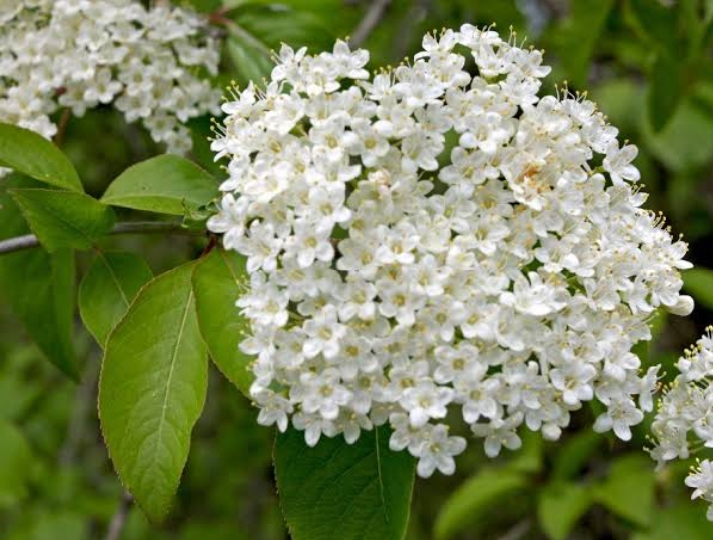
- Scientific Name: Viburnum prunifolium
- Other Names: Sweet haw
- Nature: Deciduous shrub
- Flowers: Creamy White
- Height: 15-20 feet
- USDA zones: 3 through 9
Black-haw viburnum is a large shrub or a small tree that can grow to be 15-20 feet tall with a relatively large spread. The leaves of the Blackhaw Viburnum are ovate or elliptical in shape and are dark green in color. They measure around 2-4 inches long and 1-2 inches wide. In the fall, the leaves turn a purplish-red color before falling off. The bark is reddish-brown, very rough on old stems. The branchlets are red at first, then green, finally dark brown tinged with red.
In the spring, the Blackhaw Viburnum produces clusters of small, white flowers that are very fragrant. These flowers are followed by blue-black berries that are edible and often used to make jams and jellies. Blackhaw Viburnum is a low maintenance plant and you can use it as a hedgerow or as an accent plant in a mixed border.
The Wayfaring Tree
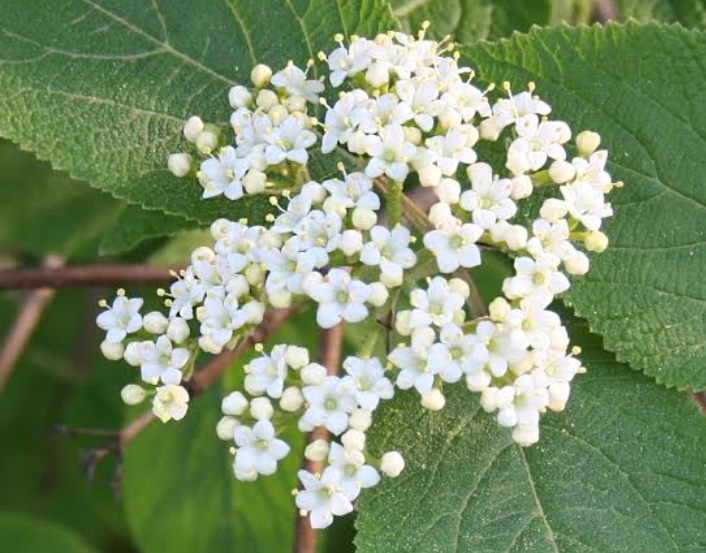
- Scientific Name: Viburnum lantana
- Other Name: Wayfarer
- Nature: Deciduous shrub
- Flowers: Creamy-white
- Height: 6-12 feet
- Native Area: Asia and Europe
- USDA zones: 3 through 9
The Wayfaring Tree also referred to as Wayfarer grows to heights of between 10 and 15 feet, although it can grow beyond 18 feet when grown in places with conditions similar to its native environment. If you’re not keen, it’s easy to confuse the Wayfaring tree with the Nannyberry shrub. It features branches that are upright and spreading with irregular or rounded shape. The leaves are oval-shaped dark green in color and approximately 2-4 inches long with a slightly serrated edge.
The flowers are white, and are produced in clusters, blooming in the spring. The fruit is a black or red berry-like drupe, which ripens in the fall and is edible but not very tasty. In many places around the word, particularly North America and Europe this treelike shrub is used as a hedging plant and it will often be seen in countryside, on the edge of woodlands and sometimes as a way-side shrub.
Sandanqua viburnum
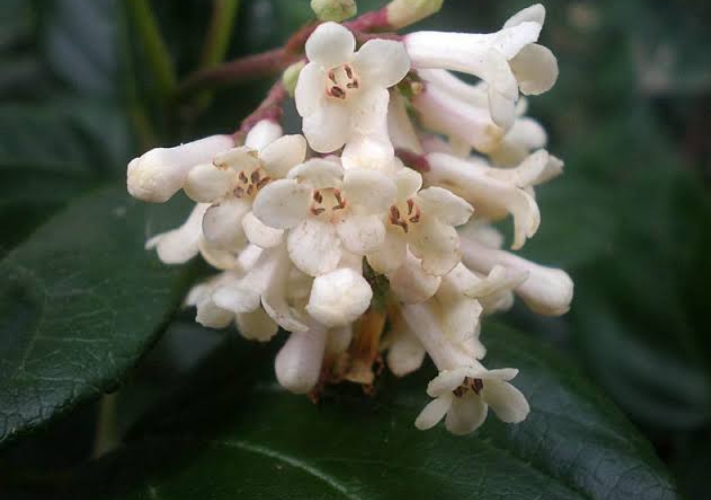
- Scientific Name: Sandyanqua viburnum
- Other Name: Sandyanqua
- Nature: Deciduous shrub
- Flowers: White or pink flowers
- Height: 8-10 feet
- Native Area: Asia
- USDA zones: 5 through 8
Sandyanqua viburnum, also known as “Sandyanqua viburnum” or “Sandyanqua,” is native to is native to Japan, specifically Okinawa and other surrounding islands. It is a vigorous shrub or small tree that can grow beyond 18 feet tall, although it is often much smaller in cultivation. One of the most easily noticeable characteristics of Sandyanqua viburnum is its attractive glossy, dark green foliage.
In the spring, the shrub produces clusters of small white or pink flowers that are held on long, slender stems. The clusters of flowers are eventually followed by clusters of red or black berries in the fall. Sandyanqua viburnum is a versatile plant that can be used in a variety of garden settings. It can also be an excellent shrub for naturalizing in woodlands or along streams. Sandyanqua Viburnum is hardy and can survive in USDA hardiness zones 5 to 8.
Siebold viburnum
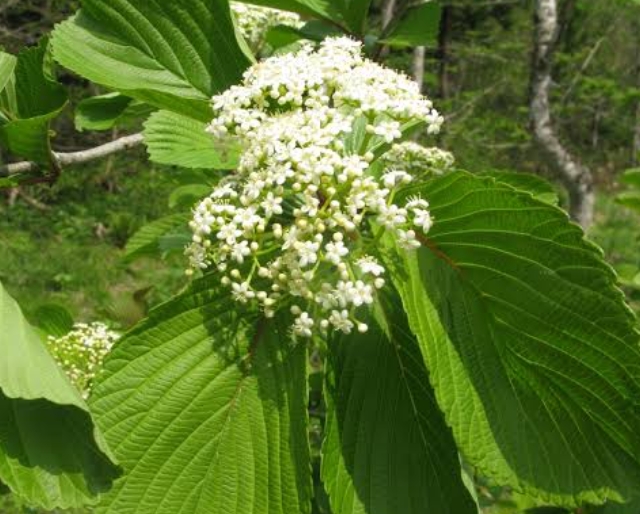
- Scientific Name: Viburnum sieboldii
- Nature: Deciduous shrub
- Flowers: White
- Height: 8-20 feet
- Native Area: Asia
- USDA zones: 4 through 7
The Siebold viburnum is a large deciduous shrub or small tree that is native to Asia (Japan, China, and Korea). It is known for its attractive, broadly ovate leaves that are glossy green on the upper surface and pale green on the lower surface. The leaves can be as much as 4 inches long and 2 inches wide. The Siebold viburnum can grow up to approximately 20 feet tall, but can be pruned to be kept smaller.
In the spring, the plant produces large clusters of white, lacecap-like flowers that are quite showy. The flowers are followed by bright red berries that ripen to black in the fall. Given that it’s a large shrub, the plant can make a good hedge especially when grown in rows. The plant can also work well when grown along streambanks and naturalized areas.
Nannyberry
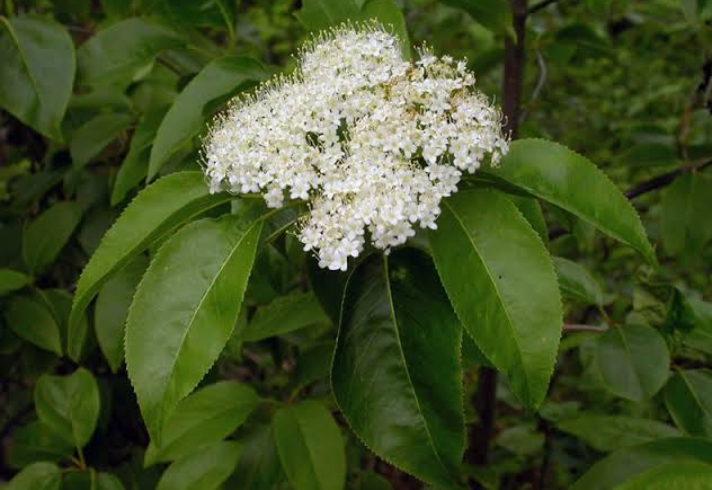
- Scientific Name: Viburnum lentago
- Other Names: Sheepberry
- Flowers: White
- Height: 8-20 feet
- Native Area: Asia
- USDA zones: 2 through 8
Viburnum lentago, commonly known as nannyberry or sheepberry, is native to eastern North America. This a favorite ornamental shrub for many home gardeners in North America, mostly valued for its fruit and fall color. It grows up 20 feet tall featuring a short trunk, rounded canopy and pendulous, flexible branches. The bark is reddish- to grayish-brown, and broken into small scales.
The leaves of nannyberry are simple and opposite, with a smooth, glossy texture. They are 2-5 inches long and 1-3 inches wide, and have a pointed tip and a slightly wavy margin. The color is dark green during the growing season, and turns a yellow-red or orange-red to purplish-red in fall.
In the late spring and early summer, nannyberry produces clustered flowers with white petals. These flowers are then followed by clusters of small, blue-black berries in the fall, which are edible and quite popular with birds. The fruits usually ripen in September and October. They are edible but bland, but often used for making jelly or pie.
Burkwood viburnum
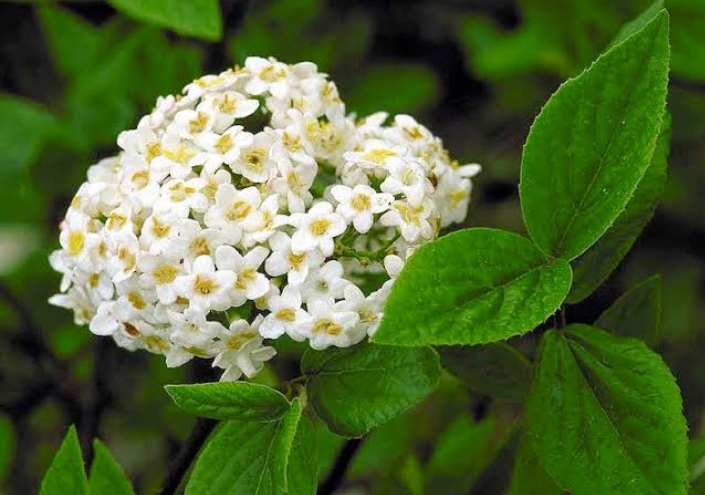
- Scientific Name: Viburnum x burkwoodii
- Flowers: White
- Height: 6-8 feet
- USDA zones: 1 through 8
Burkwood viburnum is a hybrid plant that is a cross between the Viburnum carlesii and Viburnum utile. This shrub when growing in home yards can reach to be 6-8 feet tall and wide. The leaves of the Burkwood viburnum are dark green with a glossy surface and are somehow elliptical in shape. The plant produces clusters of small, white, fragrant flowers in the spring, which are followed by small, red berries in the fall.
In North America, this plant is quite popular and you can spot it growing as a screen or hedge plant in home gardens. Another thing to note is that Burkwood viburnum is hardy in zones 1-8 and to have the best cross-pollination and fruit display, you need to plant it in groups rather than as specimens.
Judd viburnum
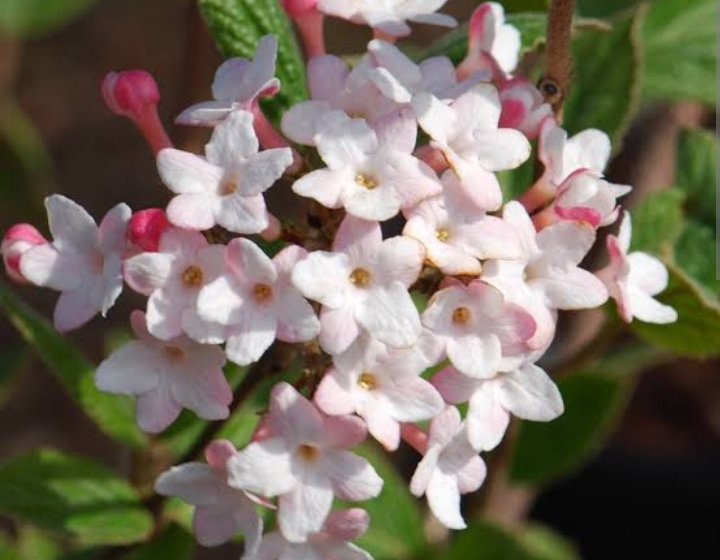
- Scientific Name: Viburnum x Juddii
- Flowers: White
- Height: 5-7 feet
- USDA zones: 4 through 7
The Judd viburnum, also known as Viburnum Juddii, a hybrid shrub created in the 1920s and grows 6-8 feet tall and wide with an upright rounded habit. The leaves are generally glossy and lush green in color. The plant produces small, white flowers in large clusters, the clusters are flattened and can be up to 5 inches across. The flowers profusely bloom in early spring, depending on the location. Each flower has five petals and a central cluster of fertile, yellow-tipped stamens.
The flowers are followed by small, glossy, black drupes that are about 1/4 inch in diameter. The Judd viburnum is hardy in USDA zones 4-8. This means that Judd viburnum can tolerate a wide range of temperatures, from very cold to mild and can be grown in a large part of the United States, including states such as Ohio, Indiana, Illinois, Michigan, Missouri, Iowa, Wisconsin, Minnesota, Nebraska, and some parts of Texas, Oklahoma, Kansas, Arkansas, and Louisiana.
Shasta Viburnum
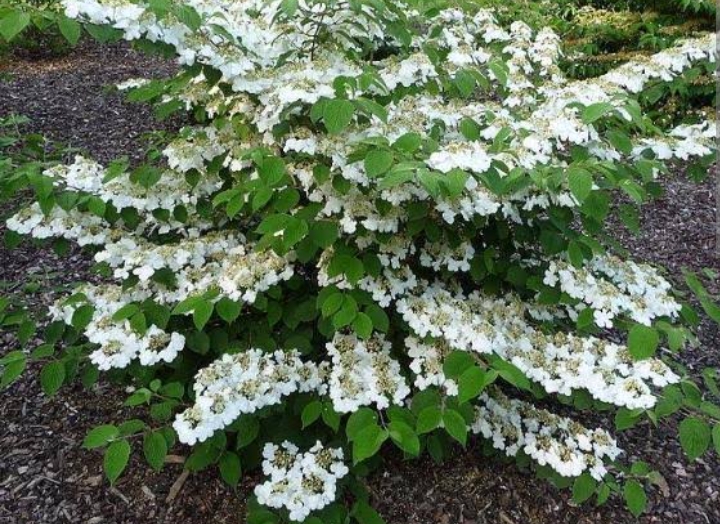
- Scientific Name: Shasta Viburnum
- Flowers: White or yellow
- Height: 4-6 feet
- USDA zones: 5 through 8
Shasta Viburnum will grow to a height of between 3 and 6 feet with a spread of about 4-6 feet. The flowers bloom in the spring, they can be yellow but usually they are white. The flowers are followed by small, black drupes that are about 1/3 inch in diameter. The fruit is edible but not commonly consumed as it is not particularly flavorful.
Shasta Viburnum is hardy in USDA zones 5-8, which means it can tolerate temperatures as low as -20 to -10 degrees Fahrenheit. This makes it suitable for growing in a wide range of climates, from the colder regions of the Midwest and northeastern United States, to the warmer regions of the Southeast and West Coast.
David Viburnum
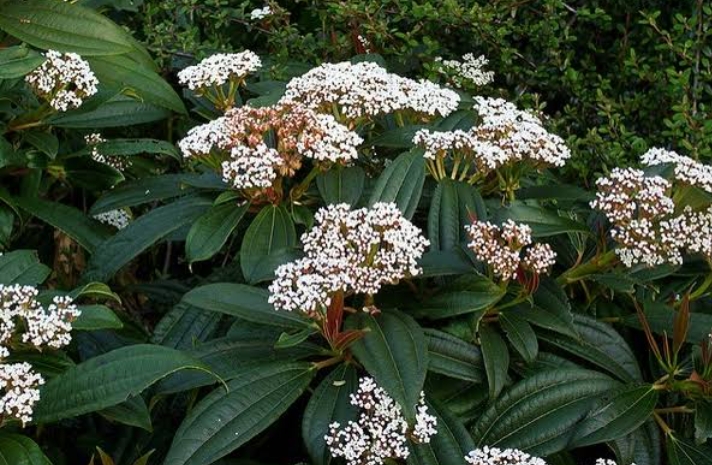
- Scientific Name: Viburnum davidii
- Flowers: White
- Height: 4-10 feet
- USDA zones: 4 through 8
David Viburnum generally can grow up to 10 feet tall and wide and will spread slowly by suckers to form a large colony. The size of the plant can vary depending on the growing conditions and the amount of pruning and maintenance it receives. This shrub is native to China and is quite loved by many people for its attractive foliage and beautiful flowers.
David Viburnum has showy, pinkish-white flowers that bloom in the spring. The flowers are small and appear in clusters, called cymes, before the leaves emerge. The flowers are also very fragrant and can be enjoyed by humans. After the flowers have bloomed, they will be replaced by small, black-blue drupes that ripen in late summer and fall. It is essentially a good shrub for naturalizing in woodlands or along streams.
Eskimo viburnum
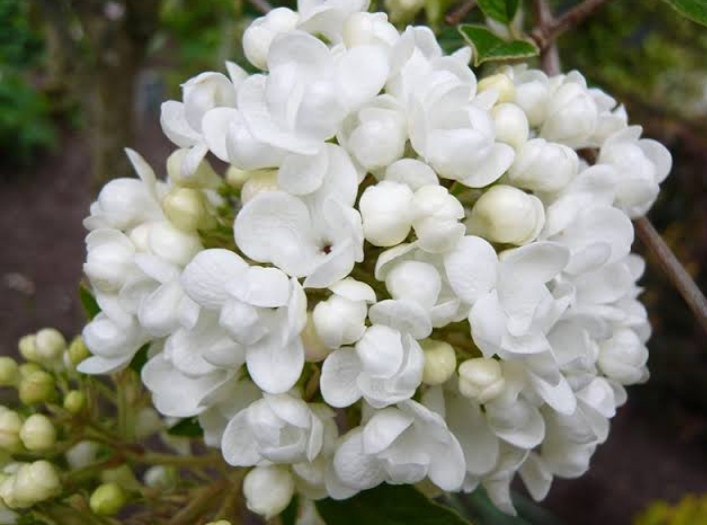
- Scientific Name: Viburnum eskimo
- Nature: Semi-evergreen
- Flowers: White
- Height: 6-8 feet
- USDA zones: 2 through 7
‘Eskimo’ viburnum is a semi-evergreen shrub that was registered and released into commerce by The United States National Arboretum in 1981. The plant is a cross between viburnum carlcephalum ‘Cayuga’ and viburnum utile. The plant produces white flowers that resemble snowball in early spring, before the leaves appear on the plant. The flowers are actually the main striking feature of the plant, as they contrast nicely with the dark green leaves. When grown as a hedge or screen plant, this plant is amazing and can grow quite tall and dense.
The Eskimo viburnum produces clusters of small scarlet berries in the summer, following the blooming period. The berries eventually mature to blue-black color. These berries are edible and are often used to make jams and jellies. They are also eaten by wildlife, such as birds and bears. This plant is a hardy plant that can survive in a wide range of climates. It is considered to be hardy in USDA Plant Hardiness Zones 2-7.
Prague viburnum

- Scientific Name: Viburnum “Pragense” or Viburnum x pragense
- Other Name: Pragense viburnum
- Flowers: White
- Height: 6-10 feet
- USDA zones: 5 through 8
Also known as the Pragense viburnum is a broadleaf evergreen shrub that is a cross between V. rhytidophyllum and V. utile that grows 8-12 feet tall and wide with an oval to rounded form. Its dark green leaves are simple and about 2 to 4 inches long. Pink buds open to creamy white or ivory flowers in May, transforming to showy red berries. These berries eventually turn a glossy black and persist through the end of December, providing interest and color during the garden’s low season.
The Prague Viburnum is hardy in USDA zones 5-8, which means that it can survive in temperatures as low as -20 degrees Fahrenheit. The Prague viburnum can be grown in groups as a hedge plant, or with plants of other varieties to form a mixed hedge. The shrub is relatively low maintenance, and it is easy to care for. It is drought tolerant and it is also relatively pest and disease free.
Leatherleaf viburnum
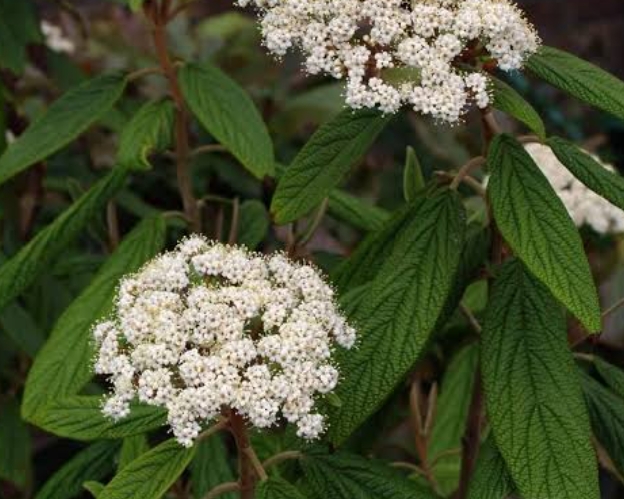
- Scientific Name: Viburnum rhytidophyllum
- Other Name: Wax viburnum
- Flowers: White
- Height: 6-10 feet
- USDA zones: 6 through 9
Leatherleaf viburnum is a large shrub or small tree that is native to China and Japan. It is known to grows between 10 and 15 feet tall and as wide as 4 or 6 feet. Leatherleaf viburnum is also sometimes called the “wax viburnum” because of the waxy coating on the dark green, glossy leaves. It is considered to be an evergreen in warmer climates, but it may lose some or all of its leaves in colder areas. It can also be grown as a deciduous plant in colder zones, which means it will lose its leaves and go dormant in the winter.
Leatherleaf viburnum feature white clustered flowers that bloom in the spring. They are not as showy as the foliage or the fruit, but they do add beauty to the overall appearance of the plant. The flowers are arranged in large, flat-topped clusters that can be up to 6 inches across. In North America, most gardeners prefer to use this shrub for foundation planting around the house or as a specimen plant, either alone or in groups.
Cinnamon viburnum

- Scientific Name: Viburnum cinnamomifolium
- Flowers: White
- Height: 6-12 feet
- USDA zones: 5 through 8
Cinnamon viburnum is native to China and Japan. This shrub grows to approximately 8 feet tall though, it can reach up to 12 feet tall when provided with best growing conditions. It generally has a dense, rounded shape and a moderate growth rate. It is hardy in USDA zones 5-8 and is adaptable to different soil types, but prefers well-drained soil. It can be planted as a privacy barrier, to block an unsightly view in the garden.
The leaves of Cinnamon viburnum are one of the plant’s most notable features. They are glossy, dark green in color and relatively wide. The leaves have a unique cinnamon-like fragrance when they are crushed, hence the name of the plant. The leaves of this plant are also long lasting and hold their color well into the fall, before they drop from the plant. This viburnum produces clusters of creamy-white flowers in the spring. The flowers are followed by small, black berries in the fall, which are not edible for humans but are attractive to birds.
Henry’s Viburnum

- Scientific Name: Henry’s Viburnum
- Flowers: White
- Height: 4-15 feet
- USDA zones: 5 through 8
Henry’s Viburnum is a medium to large sized shrub, typically growing up to 15 feet in height. The leaves are glossy and dark green ovate in shape, with smooth margins and a pointed tip. One of the most beautiful features of Henry’s viburnum is its fragrant white flowers. These flowers bloom in the spring and are incredibly showy. The flowers are arranged in large clusters and have a delicate, lace-like appearance.
The berries of Henry’s viburnum are small and typically red or black in color. They appear in the fall, typically in late September or early October. They are round and glossy, and are about 1/4 inch in diameter. Henry’s Viburnum is hardy in USDA zones 5-8. In other words, it can tolerate winter temperatures as low as -20 to -10 degree Fahrenheit (-28 to -23 degree Celsius) which is a characteristic of zone 5 and can survive temperatures as high as -10 to 0 degree Fahrenheit (-23 to -18 degree Celsius) which is typical of zone 8.